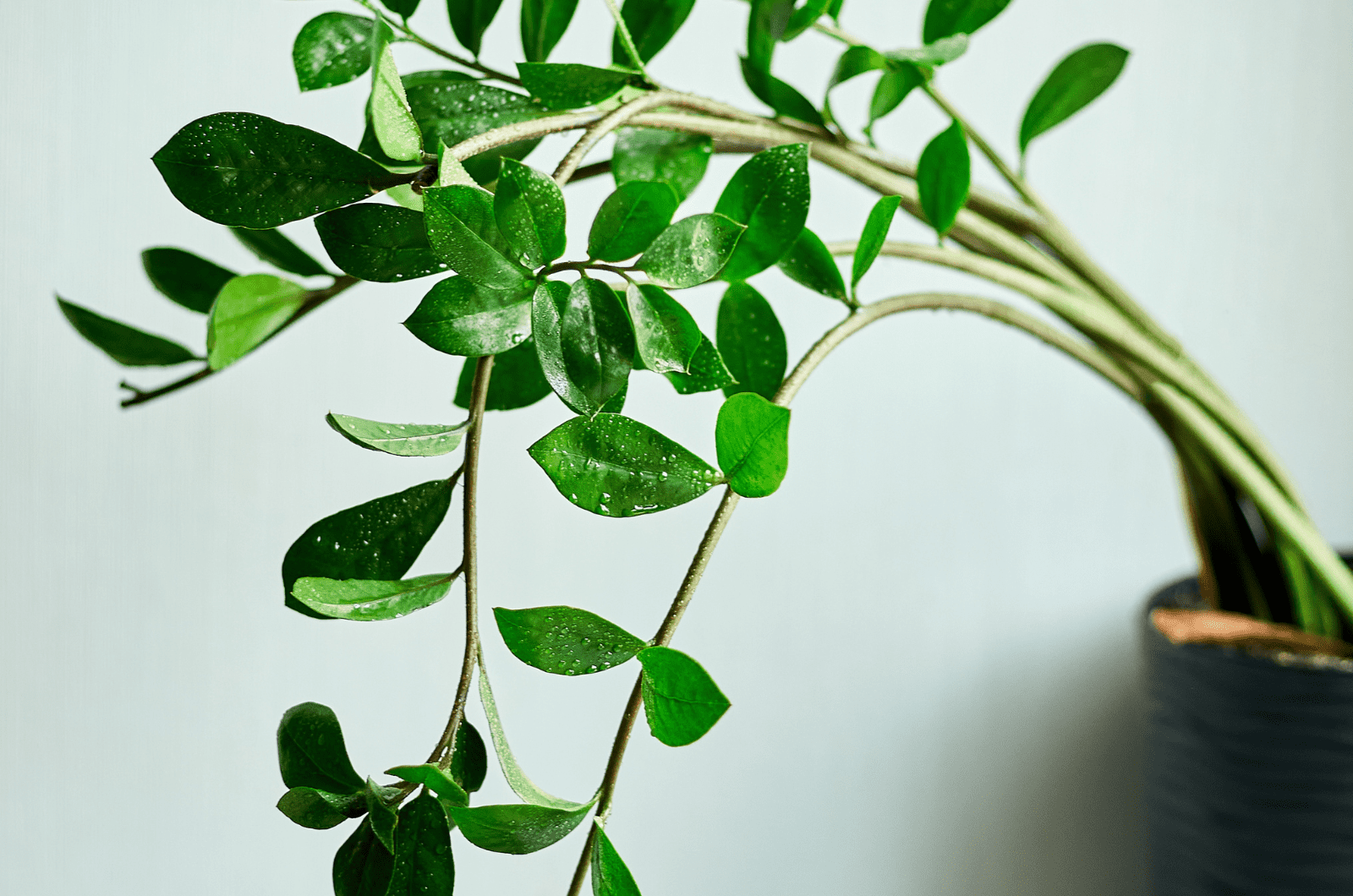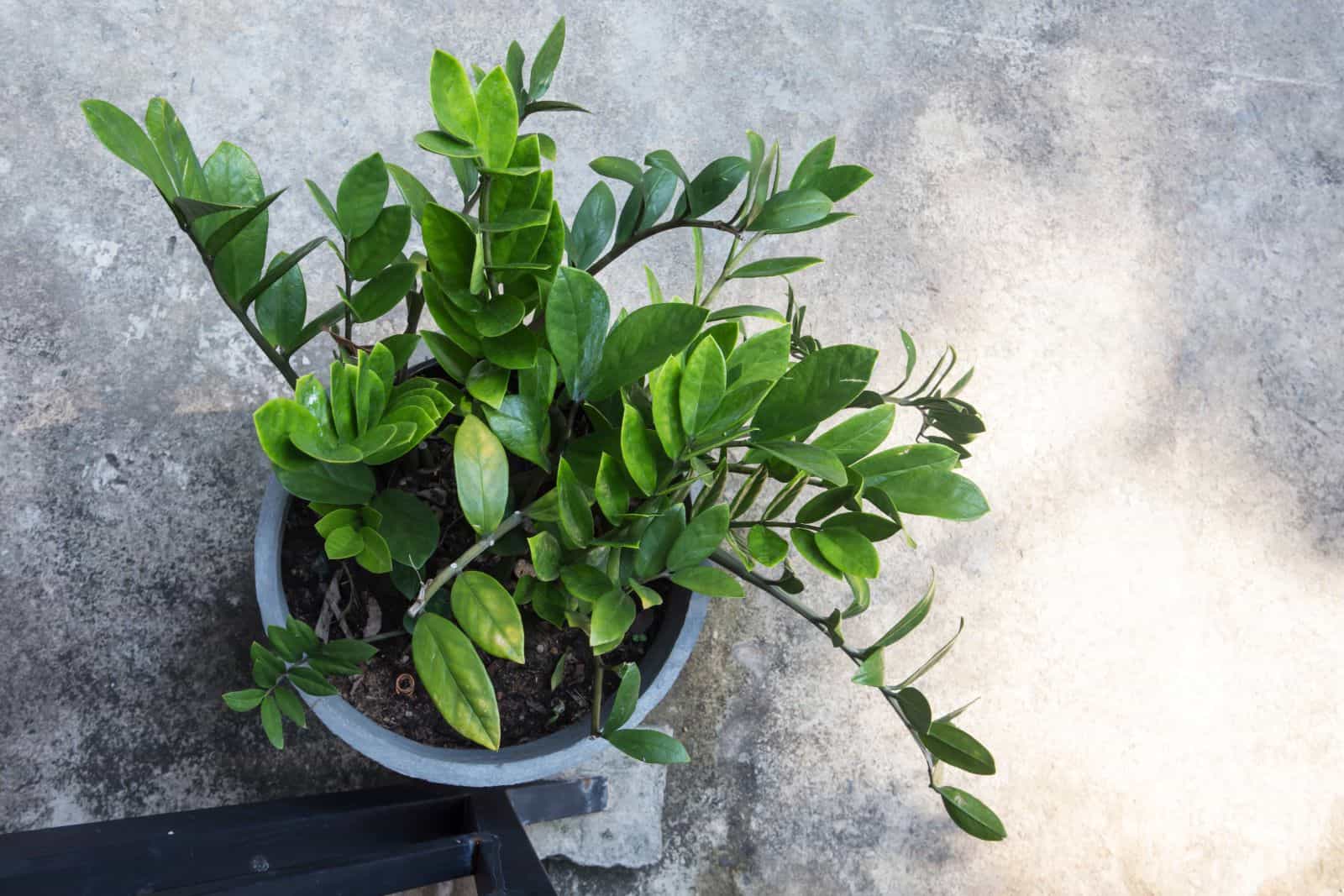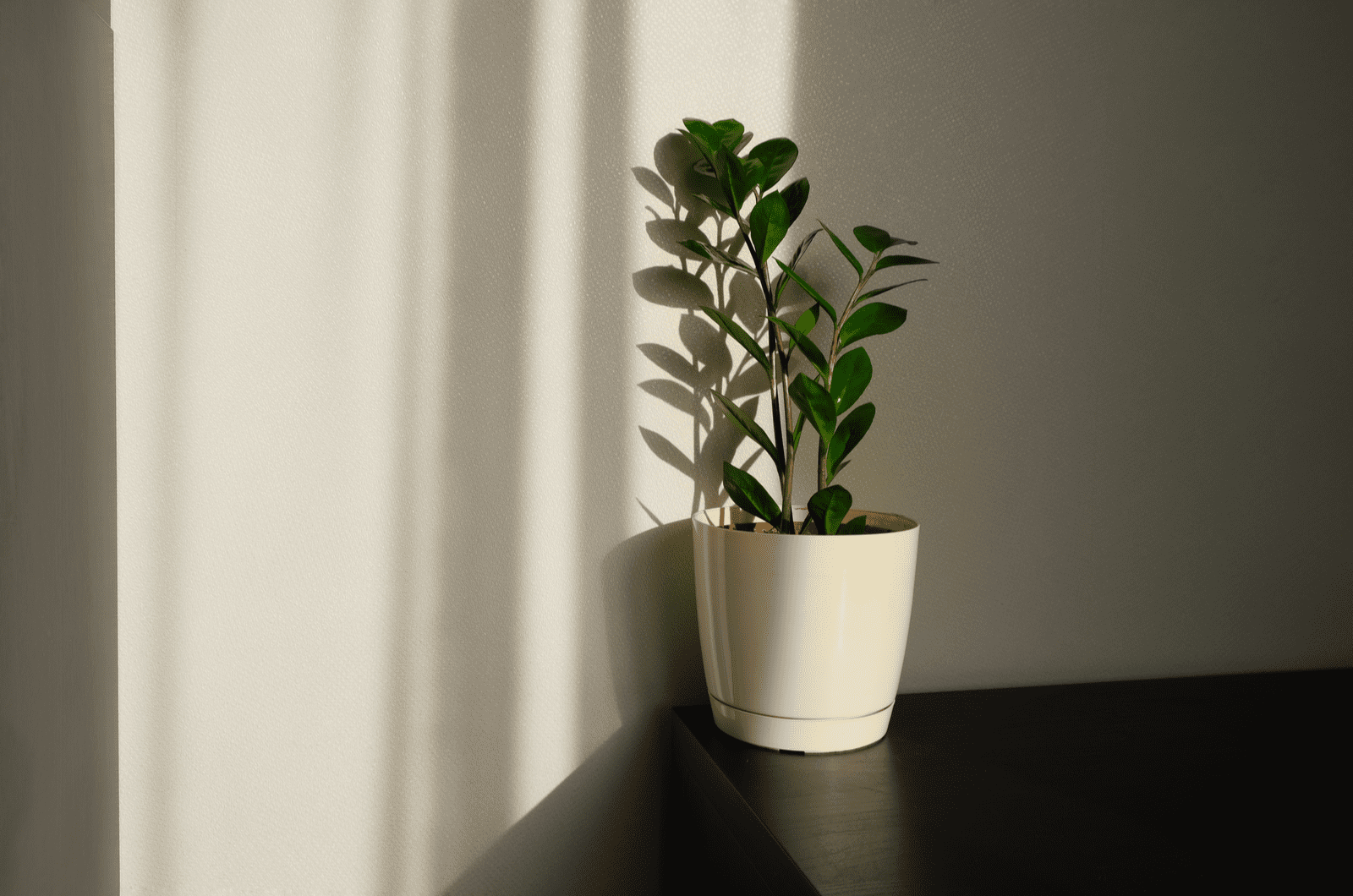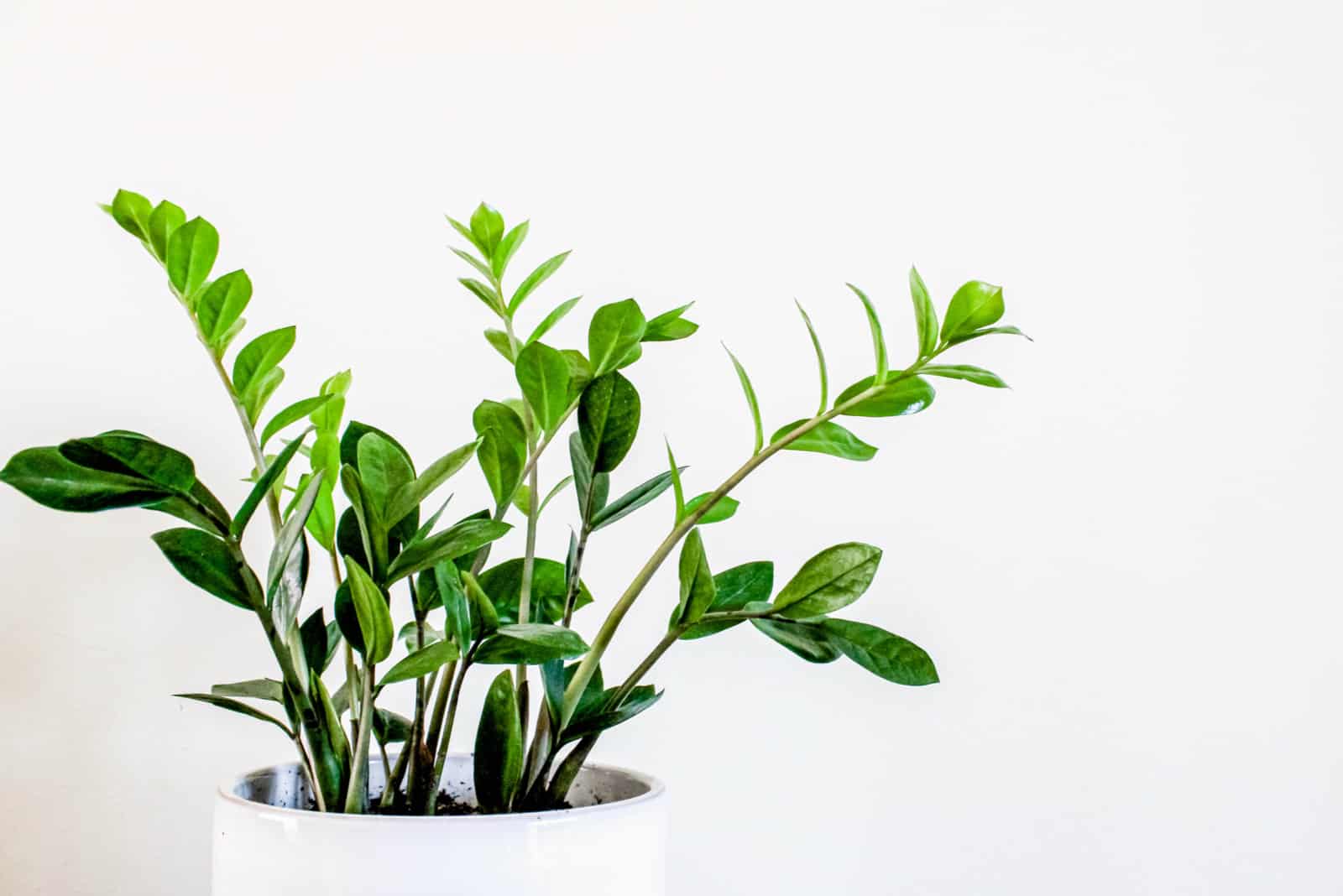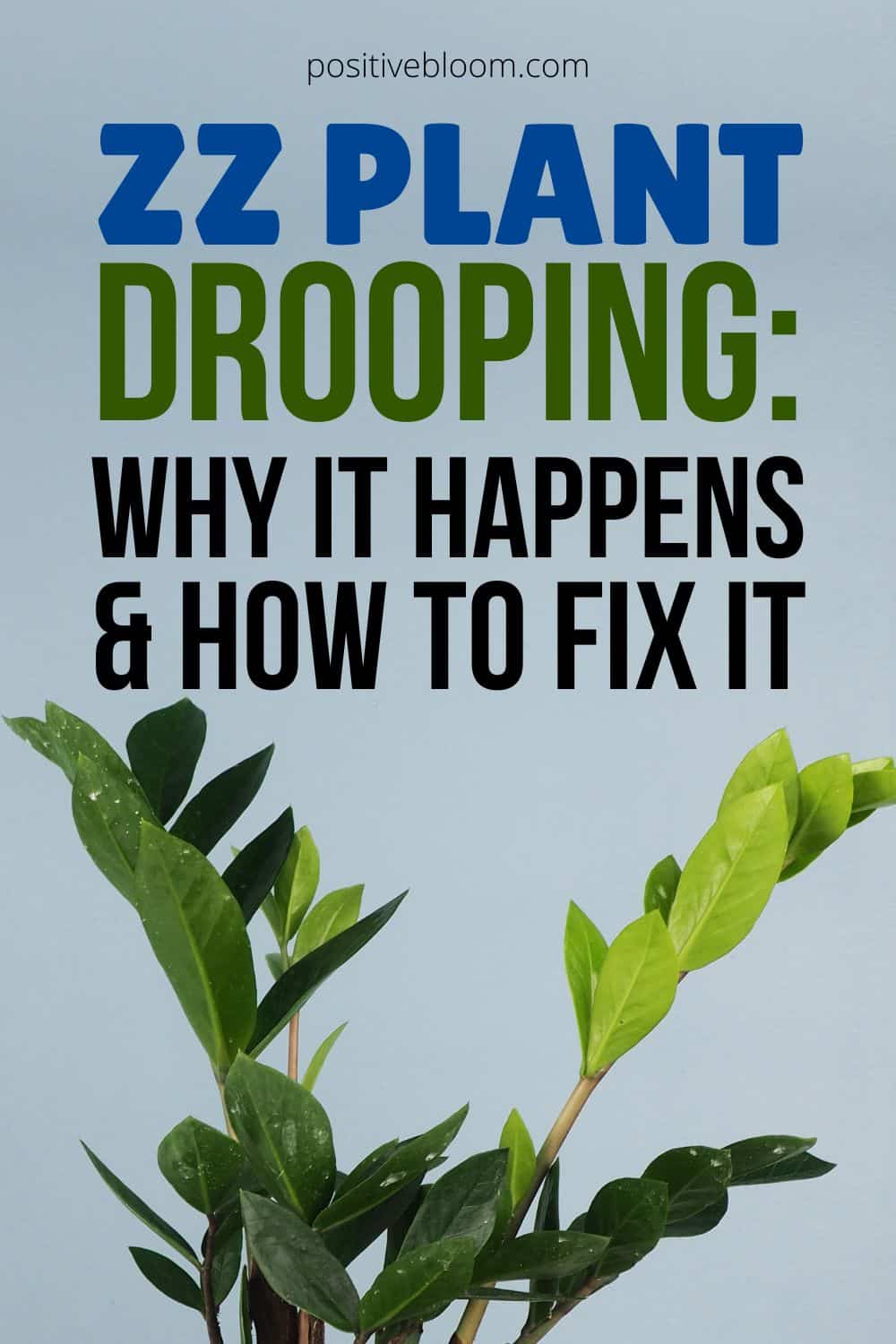The Zamioculcas zamiifolia plant has, in my humble opinion, the most interesting name of all plants: ZZ plant.
The name is simple and perfectly fits this plant as it’s really simple to care for. It’s no wonder you can find it growing in households all over the world.
Your ZZ will show you signs of stress if all its requirements aren’t being met. If you notice your ZZ plant drooping, something has gone wrong. You’ll need to inspect your plant further and check if each condition is correct.
I’ll show you the most common causes of drooping, as well as how to fix the issue, so read on to find out everything you need to know!
Why Is Your ZZ Plant Drooping?
ZZ plants may droop due to watering issues (overwatering or underwatering), poor light conditions, low temperatures, or lack of fertilizer. Your ZZ may also be rootbound or suffering from transplant shock or physical damage.
Let’s get into details!
Overwatering
If you ask any gardener or plant lover their biggest fear, whether they’re a beginner or have a lot of experience, their answer will be OVERWATERING!
So, what’s the deal with overwatering and why is it so dangerous? As we all know, plants (just like humans and animals) can’t live without water.
But for plants, in this case ZZ plants, that may be tricky to understand. Animals and humans take as much water as they need, but houseplants depend on us to give them water.
Your ZZ will droop if its soil is waterlogged, which is when the roots are surrounded by too much water.
Let me tell you how this happens: when you water your ZZ plant, you ensure there’s enough water for the rhizomes (or ZZ plant bulbs, as some refer to them) to absorb. The roots also absorb food and send both to the other ZZ plant parts.
The soil has air pockets responsible for air circulation, which provides the rhizomes with the necessary oxygen. Excess water clogs these spaces up and restricts the airflow, and as a result the rhizomes receive too much water. When they can’t absorb more, they stop functioning.
Without healthy and functioning roots, your ZZ won’t get enough food and water, which results in drooping.
There are some other signs that indicate overwatering, which can help you determine what’s wrong with your ZZ.
Signs Of Overwatered ZZ Plant
The most dangerous consequence of overwatering is root rot. The biggest problem is that this disease is hard to discover as the roots aren’t visible.
However, the soil can help you determine if your ZZ has root rot. If you spot mushy soil, give it a smell, and if it has a foul odor you might have a problem.
Additionally, you may notice black spots on your ZZ plant and yellow leaves.
This is how the parts of the plant above the soil can help you figure out what’s happening below the soil line.
Underwatering
Another issue related to watering is not providing enough moisture. Many gardeners fear overwatering, and for good reason, and decide to delay watering to avoid potential waterlogging.
The problem with delaying watering is that we may face another issue – underwatering. Although dry soil isn’t as dangerous as waterlogged, it doesn’t mean it won’t damage the plant.
This especially refers to situations when plants grow in dry soil for an extended period.
The ZZ plant’s rhizomes can’t send water and nutrients if they don’t have any. As a result, your ZZ will droop.
The easiest way to determine if your ZZ is lacking water is by observing the soil. It will be lighter in color and have cracks if it needs water.
There are some other signs that indicate you’re dealing with a dehydrated ZZ.
Signs Of An Underwatered ZZ Plant
If you notice your ZZ plant leaves turning yellow, it’s a sign that it’s thirsty. How can you tell for sure if you are dealing with an overwatered or underwatered ZZ?
Yes, yellow leaves will occur in both cases, but other things may tell you exactly which one is causing the issue.
For example, if your ZZ lacks water the leaves will turn brown and the edges will be crispy and curly.
General wilting and drooping occur as a sign of stress caused by underwatering.
Low Temperatures
The ZZ is a tropical plant, so it needs warmer temperatures.
65-70 degrees Fahrenheit is the ideal temperature range for a Zamioculcas zamiifolia. The essential thing to understand about your ZZ is that it doesn’t tolerate low temperatures, unlike some other indoor plants.
Of course, 55 degrees Fahrenheit won’t kill your ZZ, but anything lower than 45 degrees Fahrenheit will adversely affect this plant.
If you notice that you have a droopy ZZ plant, check the thermostat. If you don’t have one, consider getting one as it really helps when you’re growing houseplants.
You’ll need to be extremely careful not to let the temperatures get too low. Cold can cause brown stems that eventually fall off. Your ZZ may die if left in cold temperatures for an extended period.
Low Light Or Direct Sunlight
Although light conditions seem like the easiest to fulfill, all gardeners (including myself) will tell you differently! Yes, it gets easier once you choose the right location, but remember that seasons change so sun exposure will lower or increase at some point.
For ZZ plants, the appropriate light level is the key to healthy growth.
ZZ plants adapt well to low light, but won’t tolerate it if it’s too low, nor will they survive if not provided with enough bright light.
If you place it in low light, you’ll notice it drooping and wilting because the plant can’t perform photosynthesis.
Additionally, stunted growth is mostly caused by low light conditions.
On the other hand, your ZZ won’t grow well in direct light either. As a matter of fact, direct sunlight can cause bigger issues than low light.
The leaves will display discoloration or get sunburned if in the sun for too long.
Yellow and scorched leaves are also sure signs of too much light exposure.
Under fertilization
The ZZ plant isn’t fussy about food, but that doesn’t mean it can grow without it. Drooping stems are the most common consequence of under fertilization.
If you notice the leaves turning yellow and have ruled out the above mentioned causes, check if your ZZ needs food.
But be careful as overfertilization may also cause the leaves to turn yellow.
Remember when you last fed your ZZ and if you used the right type of fertilizer.
ZZ Plant Stems Drooping Due To Transplant Stress
A very common reason for a Zanzibar gem drooping is transplant stress. This usually occurs after repotting as the ZZ needs time to adapt.
Not many plants react to repotting like a ZZ.
If you repot your ZZ and notice its stems drooping, check if the roots or the stem are damaged.
This can tell you the cause.
ZZ Plant Stalks Falling Over Due To Physical Damage
It’s not normal to see plants physically damaged. All growers handle their plants with care, especially the leaves and stems because they are so delicate.
However, small children and pets may accidentally damage parts of the plant. Pulling is the most common cause of damage.
Not only can small children damage plants, but you can also do so if you pull your ZZ too hard when removing it from the pot before repotting.
Your ZZ Is Rootbound
We mainly choose pots based on their appearance without paying much attention to the size or material it’s made out of.
However, for the plants themselves the pot’s looks don’t mean much, so you should consider other things when purchasing one.
The size of the pot is the first thing that should be discussed. A mature 3 foot tall ZZ plant won’t grow well in a smaller pot that once fit your juvenile plant.
Too small a pot won’t leave enough space for the roots to spread, and they will entangle and cause the ZZ plant to become rootbound.
The consequences of a lack of space in the pot for the roots is drooping stems because the root system can’t support them.
Additionally, the low soil in small pots doesn’t provide the ZZ’s roots with enough nutrients and water, causing the plant to display stunted growth and drooping.
How To Revive A Drooping ZZ
It’s now time to find out how to revive this plant, which is especially important if you use the ZZ plant for Feng shui.
If your ZZ is drooping, you’ll need to inspect it further, and once you find the cause you can start reviving it.
The first thing you should do if your ZZ is drooping due to watering issues is change your watering habits. You need to know when and how to water your ZZ, as well as which type of water to use.
You’ll also need to set the temperature according to the ZZ’s requirements. You’ll then need to consider relocating it if it either lacks or receives too much light.
If the fertilizer causes drooping, you’ll need to use a new fertilizer and change the fertilizing schedule.
Change Your Watering Habits
To avoid watering issues, you’ll need to know exactly when and how to water ZZ plants. When it comes to preventing and avoiding overwatering, it isn’t just about delaying watering because you can face another issue.
We’ve seen that lack of water will also affect your ZZ, so what should you do?
First, let’s discuss the watering schedule. Unlike other common houseplants, such as Philodendrons, ZZ plants don’t need much water, and you don’t need to water them when only the topsoil is dry.
This is because Zanzibar gem plants are semi-succulents, which means that the underground, potato-like structures have the ability to store water. If they are full-succulents, the leaves would have this feature.
As you may assume, ZZ plants don’t require frequent watering, and never until the soil dries out entirely.
Therefore, a fixed watering schedule for ZZ plants doesn’t exist! You’ll need to rely on yourself and learn to check if the soil is dry enough.
How To Check Soil Moisture Content
You can use a few methods to help you determine if it’s time to water your ZZ plant.
The first method is lifting the pot. Soil with higher moisture content will be heavier, so you’ll need to wait a little bit more before watering again.
Another method is looking at the color of the soil. Light brown soil is a sign of less water content, therefore, the lighter the soil, the sooner it needs watering.
The third method is by using your finger. Although this works better for plants that require more moisture in the soil, it can aid in determining the moisture content when combined with the methods above.
The truth is that the above mentioned methods aren’t 100% reliable, so what’s the most reliable method to help you determine soil dryness?
A moisture meter is a device you should definitely get for yourself. It’s very helpful for gardening purposes, is 100% reliable, and beginner growers also enjoy using it.
Once you’ve determined that it’s time for watering, you should learn how to water your ZZ plant.
How To Water A Zamioculcas Zamiifolia
Dry soil means that your ZZ plant is thirsty and that you should give it a lot of water. By this, I mean watering the plant thoroughly, as your ZZ won’t benefit much from light watering.
When I started growing plants, I used a watering can to pour water onto the plant, including the leaves.
But that habit taught me a valuable lesson – never water the leaves of your plants!
First, the leaves will soften and need more time to dry. The most common scenario is that the leaves rot and fall off.
Another thing I noticed is that it’s harder to saturate the soil enough when using a watering can and the top watering method.
I started to use the bottom watering method, and I highly recommend using this method for watering your ZZ plants. This is because the soil gets enough moisture by absorbing the water gradually, making it easier to avoid both overwatering and underwatering.
Fill half of the sink or larger pot with water and gently place your ZZ in it. Now, be patient and wait for 10-15 minutes until the soil becomes saturated enough.
Then take your ZZ plant out, let it drain well, and put it in its original place. Use lukewarm water to avoid temperature stress and use filtered water to avoid the harmful effects of chlorine and fluorine buildup in the water.
Adjust Temperatures
Your ZZ plant needs to be moved to a warm location. You can also remove the stems and leaves affected by the lower temperatures.
Avoid exposing it to very cold temperatures, and it will take a few weeks for your ZZ to completely recover.
Avoid placing your ZZ near air conditioners, vents, or window sills.
Fix The Lighting
The spot where you intend to place your ZZ shouldn’t only be warm, but also receive enough bright indirect light.
Let’s first discuss where to place your ZZ if it’s drooping due to direct sunlight. It’s not a good idea to place your ZZ in a dark corner of the room after it has suffered damage from direct sun.
You’ll need to find a permanent spot so that your ZZ can adapt well.
South-facing windows receive a lot of sunlight, which means that they are perfect for plants that require a lot of bright light.
If you decide to place your ZZ near a south-facing window, observe it for some time and see if it receives too much light (drooping/a leggy ZZ).
East and west-facing windows are also a good choice as the ZZ will get some sun in the mornings, and the rest of the will be spent receiving indirect sunlight.
The only spot where I don’t recommend placing your ZZ is a north-facing window. It won’t kill the plant, but it most certainly won’t provide it with enough light.
If your ZZ grows in poor light conditions it will display stunted growth. One thing might help you ensure enough light for your ZZ; grow lights. Grow lights are beneficial for plants that need more light. If you are unsure if your ZZ needs more light, consider purchasing grow lights. They are readily available on Amazon.
Change Your Fertilizing Habits
Even though these plants aren’t heavy feeders, they require a specific fertilizing schedule and a specific type of fertilizer.
For example, when buying this plant, you will get instructions to feed it once a year, but you can’t really feed it during winter.
You need to know about the growing season for ZZ plants, which lasts from April until the end of August.
Feed your ZZ once a month until the growing season ends.
Now we come to another factor crucial for plant care, the type of fertilizer to choose. You’ll find many fertilizers on the market.
However, for the Zamioculcas zamiifolia plant I recommend using a balanced, liquid fertilizer such as 20 20 20 or 10 10 10.
Repot Your ZZ
When plants face issues such as drooping, wilting, browning, or yellowing, I suggest repotting them. There are many benefits of repotting, including new nutrients and more space for the roots to extend.
It’s essential to get new and proper soil for the ZZ plant. Make sure the potting mix contains all the nutrients this plant needs. Adding peat moss or vermiculite will ensure these nutrients.
Make sure you prepare well-draining soil, which you can do by adding perlite, pumice, or coco coir.
Another trick that will help you ensure better drainage is purchasing a pot with a lot of drainage holes. This will allow the excess water from the plant’s soil to come out.
The first thing that you should do is remove your ZZ from the pot. Remember that pulling isn’t the best option because it can cause drooping.
The second step is to loosen the soil around the ZZ plant’s roots. This is also a great moment to check the roots’ overall health. If you notice that some roots are damaged or black/brown, remove them with sanitized cutting tools.
You can also divide the root ball and use the rhizomes for propagation.
Fill the new pot with soil and place your ZZ in it. Water the soil, and you’ll notice new growth in a few weeks.
If you notice any signs of stress, check if every requirement has been met. If it has, give your ZZ plant some time to adapt.
FAQs
Can the ZZ plant recover from overwatering?
ZZ plants can recover after overwatering unless the roots have suffered severe damage and none of them can function anymore. If you notice yellow leaves, black spots, mushy/moldy soil, and general drooping, take your ZZ out of the pot.
Check the root system and search for healthy roots. If all the roots are rotten, you must discard your ZZ plant. If most of the roots are healthy, remove the rotten ones with sanitized cutting tools and put the plant in new soil.
If only one or two roots are healthy, remember that you can use them for propagation.
How do you know when a ZZ plant is dying?
A dying ZZ plant will display many changes depending on the cause of death. For example, if your ZZ suffers from root rot, yellowing and drooping will occur, as well as mushy soil and black spots on the leaves and stems.
If your ZZ suffers from a pest infestation, it will have white spots, webbing, and a sticky substance on the leaves. Don’t forget to check the undersides of the leaves.
Your ZZ may also be dying due to severe dehydration, or it might be suffering from a serious bacterial infection.
The sooner you find out the cause, the easier it will be for your ZZ plant to recover.
Do ZZ plants need to be watered?
Yes, ZZ plants need to be watered even though they have the ability to store water in their rhizomes. The watering schedule will depend on the light conditions, humidity, soil type, and season.
Your ZZ needs water if its soil is completely dry. Remember that warmer temperatures cause faster water evaporation, so water more frequently in summer. Your ZZ takes a rest during winter (dormancy) so cut back on watering as the plant doesn’t use much energy.
Wrapping Up
Plants like the ZZ aren’t fussy and will thrive even if neglected a bit. Due to this feature, it has become a very popular houseplant, and many beginner growers choose it to be their first plant.
After reading this article, you now know that the ZZ isn’t completely immune to problems. Is your ZZ plant drooping? Now you can determine the cause and start reviving your plant.
Good luck and until next time!
Like this post? Share or pin it for later!

